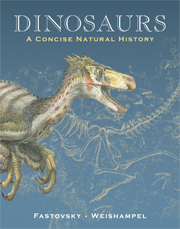Book contents
- Frontmatter
- Contents
- Why a natural history of dinosaurs?
- Dedication
- Part I Reaching back in time
- Part II Ornithischia: armored, horned, and duck-billed dinosaurs
- Part III Saurischia: meat, might, and magnitude
- Part IV Endothermy, endemism, and extinction
- Glossary
- Figure credits
- Index of subjects
- Index of genera
Part III - Saurischia: meat, might, and magnitude
- Frontmatter
- Contents
- Why a natural history of dinosaurs?
- Dedication
- Part I Reaching back in time
- Part II Ornithischia: armored, horned, and duck-billed dinosaurs
- Part III Saurischia: meat, might, and magnitude
- Part IV Endothermy, endemism, and extinction
- Glossary
- Figure credits
- Index of subjects
- Index of genera
Summary
Saurischians include the smallest of dinosaurs and the largest animals that ever lived on land; the most agile and ferocious of predatory dinosaurs and the most ponderous of plant-eaters; the brightest and, evidently, the most dim-witted of dinosaurs; the most Earth-bound and the most aerial. And stealth saurischians, birds, remain with us today, very much alive and well!
Saurischians don't have an obvious family resemblance, and you could be forgiven if you were reluctant to suppose that they are all more closely related to each other than they are to anything else. But our best evidence suggests that they are.
Saurischia: the big picture
What makes a saurischian a saurischian?
For all their differences, Saurischia is monophyletic, and is diagnosed by more than a dozen derived features (Figure III.1), two of which are shown in Figure III.2.
Recall from Chapter 4 that, as early as 1887, H. G. Seeley recognized two great clades within Dinosauria: Ornithischia and Saurischia. Having dwelled on Ornithischia for the past three chapters, we now turn to Saurischia for the next four. Seeley's Saurischia originally consisted of Sauropodomorpha (see Chapter 8) and its sister-taxon Theropoda (theros – wild beast; poda – foot; Chapters 9, 10, and 11). A modern view, however, also includes a few dinosaurs that appear to be neither sauropodomorphs nor theropods within Saurischia.
- Type
- Chapter
- Information
- DinosaursA Concise Natural History, pp. 154 - 159Publisher: Cambridge University PressPrint publication year: 2009

